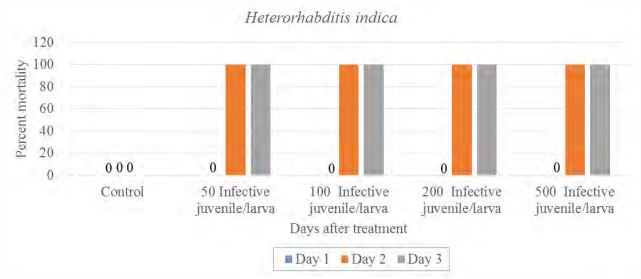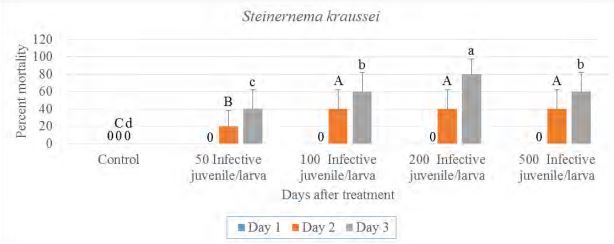Laboratory evaluation of five different species of entomopathogenic nematodes against wheat stem sawfly larvae Cephus cinctus (Hymenoptera: Cephidae)
Principle Investigator: Dr. Gadi. V.P. Reddy
Co-operators: Dr. Sindhu Krishnankutty, Dr. Brian Thompson and Debra A. Miller.
Western Triangle Agricultural Research Center, Montana State University, 9546 Old Shelby Road, P.O. Box 656, Conrad, MT 59425
Background
Infectivity of different entomopathogenic nematodes (EPNs) have been proven against hundreds of species of insects in laboratory tests. No prior information is available on the dose-response relationship of different species of EPN against wheat stem sawfly (WSS). This study aims to compare the susceptibility of WSS to different nematode species.
Objective
To assess selected species of steinernematid and heterorhabditid nematodes against WSS larva in the laboratory.
Materials and Methods
Overwintering WSS larvae were collected from wheat stubble. Wheat stubble was collected from Teton County, Montana (N47° 56' 52.1916 W112° 2' 35.5956"). Two pieces of moistened 55mm Whatman Grade 1 filter paper were placed in the lid of a plastic petri dish (55mm). Single larva of WSS were placed on the moist filter paper. EPNs were applied at the rate of 50, 100, 200 and 500 IJs/petri dish in 0.25 ml of water using a pipette. Petridish were then lined with parafilm and kept in incubator at 25 degree Celsius. Each treatment was replicated five times for each species and five replicates without nematodes for each species were served as control.
EPN species used. Heterorhabditis indica, H. bacteriophora, Steinernema kraussei, S. carpocapsae, and S. feltiae were used.
Evaluation method
Treatments were evaluated for one week following EPN application. Infection by EPN was confirmed by White Trap method. White trap method takes advantage of the natural tendency of nematodes to move to water. So if the dead larvae is infected with nematodes, nematodes will be moving away from the host cadaver to the water present in the petridish.
Statistical analysis
Mortality data was analyzed using Analysis of Variance on ranks (Kruskal- Wallis test, overall significance level = 0.05) in SigmaPlot v. 13.0 software (Systat Software Inc., San Jose, CA, USA).
Results and Discussion
Significant difference was found among the treatments (H= 15.667, d.f.= 4, P= 0.004). Among the five different EPN species, H. indica caused highest mortality (100%) within 48 hrs after the application (Fig. 1). This was followed by S. feltiae and S.kraussei that were effective with in 48 hrs of treatment application (fig 2 &3). The least effective EPN were S. carpocapsae and H. bacteriophora . Both these species caused mortality 4 days after application even at highest dose of 500 IJS/larva. None of the control died during the same time period. This results suggests that H. indica, even at very low doses, kills WSS. H. indica should be further evaluated for efficacy in field trials.
Acknowledgements
This work was supported by Montana Wheat and Barley and United States Department of Agriculture- Cooperative Regional Project W3185 Biological Control in Pest Management Systems of Plants and Montana Wheat and Barley Committee.
Figure 1. Effect of Heterorhabditis indica infective juvenile concentration on mortality of wheat stem sawfly larvae (mean ± SE).
Figure 2. Effect of Steinernema feltiae infective juvenile concentration on mortality. Different letters above the bars indicate significant differences (One way ANOVA, Kruskal-Wallis test, P= 0.05).
Figure 3. Effect of Steinernema kraussei infective juvenile concentration on mortality of wheat stem sawfly larvae (mean ± SE). Different letters above the bars indicate significant differences (One way ANOVA, Kruskal-Wallis test, P = 0.05).



